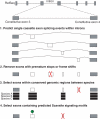Non-EST-based prediction of novel alternatively spliced cassette exons with cell signaling function in Caenorhabditis elegans and human
- PMID: 17452356
- PMCID: PMC1904267
- DOI: 10.1093/nar/gkm187
Non-EST-based prediction of novel alternatively spliced cassette exons with cell signaling function in Caenorhabditis elegans and human
Abstract
To better understand the complex role that alternative splicing plays in intracellular signaling, it is important to catalog the numerous splice variants involved in signal transduction. Therefore, we developed PASE (Prediction of Alternative Signaling Exons), a computational tool to identify novel alternative cassette exons that code for kinase phosphorylation or signaling protein-binding sites. We first applied PASE to the Caenorhabditis elegans genome. In this organism, our algorithm had an overall specificity of > or =76.4%, including 33 novel cassette exons that we experimentally verified. We then used PASE to analyze the human genome and made 804 predictions, of which 308 were found as alternative exons in the transcript database. We experimentally tested 384 of the remaining unobserved predictions and discovered 26 novel human exons for a total specificity of > or =41.5% in human. By using a test set of known alternatively spliced signaling exons, we determined that the sensitivity of PASE is approximately 70%. GO term analysis revealed that our exon predictions were found in the introns of known signal transduction genes more often than expected by chance, indicating PASE enriches for splice variants that function in signaling pathways. Overall, PASE was able to uncover 59 novel alternative cassette exons in C. elegans and humans through a genome-wide ab initio prediction method that enriches for exons involved in signaling.
Figures




Similar articles
-
RASE: recognition of alternatively spliced exons in C.elegans.Bioinformatics. 2005 Jun;21 Suppl 1:i369-77. doi: 10.1093/bioinformatics/bti1053. Bioinformatics. 2005. PMID: 15961480
-
Intronic alternative splicing regulators identified by comparative genomics in nematodes.PLoS Comput Biol. 2006 Jul 14;2(7):e86. doi: 10.1371/journal.pcbi.0020086. Epub 2006 Jun 5. PLoS Comput Biol. 2006. PMID: 16839192 Free PMC article.
-
Using mRNAs lengths to accurately predict the alternatively spliced gene products in Caenorhabditis elegans.Bioinformatics. 2006 May 15;22(10):1239-44. doi: 10.1093/bioinformatics/btl076. Epub 2006 Apr 4. Bioinformatics. 2006. PMID: 16595562
-
How prevalent is functional alternative splicing in the human genome?Trends Genet. 2004 Feb;20(2):68-71. doi: 10.1016/j.tig.2003.12.004. Trends Genet. 2004. PMID: 14746986 Review.
-
Pre-mRNA splicing and its regulation in Caenorhabditis elegans.WormBook. 2012 Mar 21:1-21. doi: 10.1895/wormbook.1.31.2. WormBook. 2012. PMID: 22467343 Free PMC article. Review.
Cited by
-
Alternative splicing: a paradoxical qudo in eukaryotic genomes.Bioinformation. 2007;2(4):155-6. doi: 10.6026/97320630002155. Epub 2007 Dec 12. Bioinformation. 2007. PMID: 21670794 Free PMC article.
-
Chromatin and epigenetic regulation of pre-mRNA processing.Hum Mol Genet. 2012 Oct 15;21(R1):R90-6. doi: 10.1093/hmg/dds353. Epub 2012 Aug 29. Hum Mol Genet. 2012. PMID: 22936691 Free PMC article. Review.
-
Identify alternative splicing events based on position-specific evolutionary conservation.PLoS One. 2008 Jul 30;3(7):e2806. doi: 10.1371/journal.pone.0002806. PLoS One. 2008. PMID: 18665247 Free PMC article.
-
Improved identification of conserved cassette exons using Bayesian networks.BMC Bioinformatics. 2008 Nov 12;9:477. doi: 10.1186/1471-2105-9-477. BMC Bioinformatics. 2008. PMID: 19014490 Free PMC article.
-
Refined annotation and assembly of the Tetrahymena thermophila genome sequence through EST analysis, comparative genomic hybridization, and targeted gap closure.BMC Genomics. 2008 Nov 26;9:562. doi: 10.1186/1471-2164-9-562. BMC Genomics. 2008. PMID: 19036158 Free PMC article.
References
-
- Johnson JM, et al. Genome-wide survey of human alternative pre-mRNA splicing with exon junction microarrays. Science. 2003;302:2141–2144. - PubMed
-
- Okazaki Y, et al. Analysis of the mouse transcriptome based on functional annotation of 60,770 full-length cDNAs. Nature. 2002;420:563–573. - PubMed
-
- Lareau LF, Green RE, Bhatnagar RS, Brenner SE. Curr Opin Struct Biol. 2004;14:273–282. - PubMed
Publication types
MeSH terms
Substances
Grants and funding
LinkOut - more resources
Full Text Sources
Research Materials

